
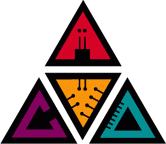 November 1996
November 1996
IEEE/ACM Supercomputing

 November 1996
November 1996
IEEE/ACM Supercomputing
Supercomputing 1994 and 1995 both were good experiences for us, and we had much more to show for November 18-21, 1996. Because the 1996 conference was in Pittsburgh, which is well within "road trip" range, we decided to bring lots of equipment. We were given a 20' x 20' display area (booth R24), and filled it with as much as we could easily carry in our 15-foot rental truck... but we move our clusters in their racks, so quite a lot of stuff fit.... Our research booth held 37 separate computers and 27 monitors; this was apparently more separate machines and video displays than any other research or commercial exhibitor.
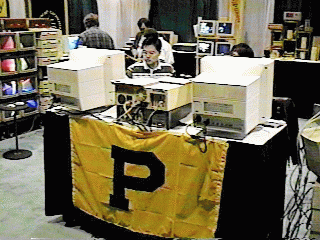 Exhibit Overview.
Exhibit Overview.
Because our booth faced a corner of the exhibit hall, we really didn't
have a "front side" to our booth. Thus, we set-up our area so that
people could move from display to display in a circle within
the booth. From the left edge of the above photo, we had the 16 PC
VGA video wall, SMP demos, 4 PC VGA video wall, history display,
Pentium cluster, and CASLE demos.
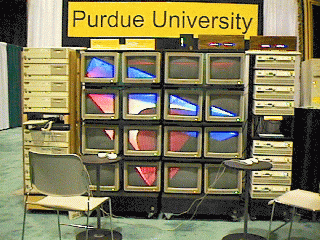 16 PC VGA Video Wall.
16 PC VGA Video Wall.
The prime demonstration within our booth was the large video wall
constructed as a 4 x 4 array using the VGA displays of 16 PCs. Each
machine was connected only to its own VGA display, and the new field
scalable 960801 PAPERS units were the only connection between
the machines of the cluster. Our demos ranged from modified "screen
savers" that treat the wall as a single display (a Qix-like one is
shown above), synchronously drawing each point or line, to an
interactive video game in which up to four players battle, each using
a mouse to control the leader of their swarm. We also had a variety
of pieces of multi-voice music playing across the PC speakers, with
each new note given to a processor selected at random. Further, a
new, somewhat crude, mini-OS running on top of Linux was used to
control the execution of the cluster.
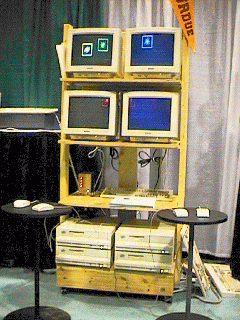 4 PC VGA Video Wall.
4 PC VGA Video Wall.
The bad news about the 16-machine cluster is that it was built using
386-based machines... including eight 386DX25 PS2 systems that were
incredibly slow for floating point (no hardware) and had very slow MCA
parallel ports (4us per register access). The four 486DX33 machines
of the 4 PC VGA video wall are no speed demons, but they were able to
run things like our combined N-body/thermal decay trace simulation in
addition to the things we built for the 16 display wall. In the photo,
they are running our four-player swarm video game.
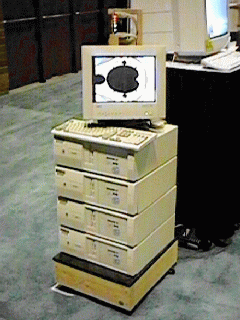
 Mandelbrot Demos.
Mandelbrot Demos.
Another interesting thing we did for the first time at Supercomputing
1996 was a side-by-side comparison of the new AFAPI (Aggregate Function
Application Program Interface) running on both a PAPERS cluster and an
SMP Linux box, as shown above. The application we used was a fully
dynamically load-ballanced shared-memory version of Mandelbrot fractal
computation, using AFAPI Replicated Shared Memory to implement a
shared display map and an array used to asynchronously claim each scan
line. Although AFAPI works well on both systems, the four Pentium 90s
in the 960801 cluster were much faster than the two Pentium 100s
within the SMP... even about 20% faster per processor. Why? Well,
the SMP has significant memory system interference between
processors....
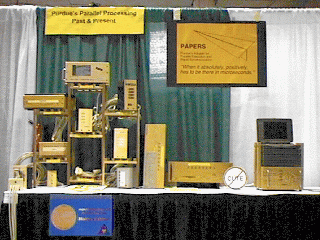 History Display.
History Display.
Supercomputing '96 had the subtheme of marking the 50th anniversary of
the field, so history displays were strongly enouraged. Thus, we
expanded the PAPERS history to include not only all previous PAPERS
models, but also a write-up summarizing some of Purdue ECE's major
contributions to the field of parallel processing. This write-up is
available on-line both as HTML and as
separate postscript files for the front and
back sides of the one-page handout.
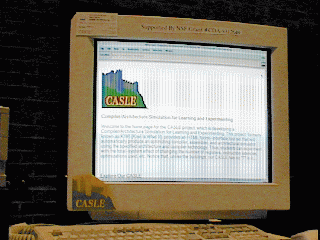 The CASLE Project.
The CASLE Project.
We also demonstrated CASLE on both Linux PCs and DEC Alphas. CASLE is
the Compiler/Architecture Simulation for Learning and Experimenting, a
teaching tool that allows undergraduate students to develop an
understanding of the total system impact of interactions between
compiler optimizations and (modestly parallel) architectural features.
More information about CASLE, including a live system that you can use
with any WWW browser, is available at http://purcell.ecn.purdue.edu/~casle/.
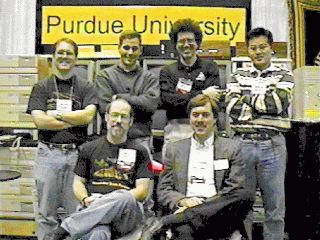 Booth people.
Booth people.
Well, after the description of what we did in our booth, it's kinda
nice to have a photo of the folks who made the booth happen. From
left to right, the PAPERS booth people are T. Mattox, R. Hoare, R.
Fisher, and S. Kim, with the two faculty, H. Dietz and G. Adams,
sitting in front. Of course, in addition to us, we would like to
thank the over 500 people who visited our research exhibit....
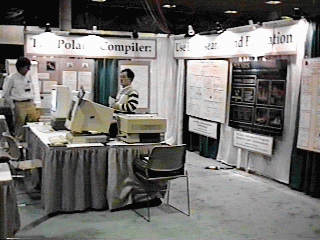 The Polaris Project.
The Polaris Project.
This year, Purdue's presence at Supercomputing was not limited to our
exhibit. Prof. Rudy Eigenmann also organized a second 20'x20'
research exhibit, for the Polaris source-to-source parallelizing
Fortran compiler. More information about the Polaris project is
available at http://dynamo.ecn.purdue.edu/~eigenman/polaris/.
Incidentally, a lot of things are available on-line from the Supercomputing 1996 conference. The complete proceedings, abstracts for the exhibits, etc., are available from http://scxy.tc.cornell.edu/sc96/.
The next public demonstration of PAPERS at a conference was April 1997 at the DOE Pentium Pro Cluster Workshop.